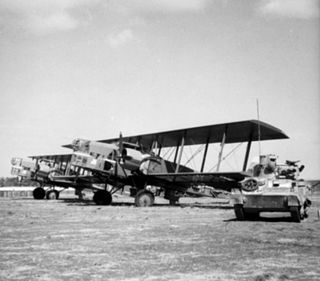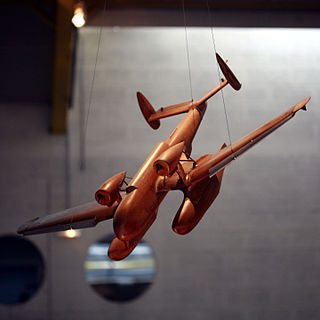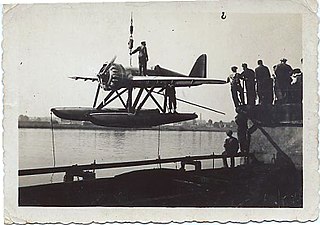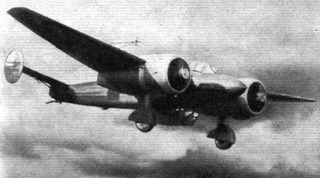
The Farman F.220 and its derivatives were thick-sectioned, high-winged, four engined monoplanes from Farman Aviation Works. Based on the push-pull configuration proven by the F.211, design started in August 1925 and the first flight of the prototype was on 26 May 1932. The largest bomber to serve in France between the two world wars was the final F.222 variant. One variation was intended to be an airliner.

The Farman F.120 and its derivatives were a family of multi-engine airliners and bombers of the 1920s built by the Farman Aviation Works in France.

The Farman F.160 was a heavy bomber aircraft developed in France in the late 1920s. It was essentially an attempt by Farman Aviation Works to modernise its tremendously successful F.60 Goliath design of the immediately postwar years. The most noticeable external difference was the larger tailfin of the new aircraft. Like its predecessor, it was a large three-bay biplane of conventional configuration with unstaggered wings of equal span. Initially conceived as a heavy night bomber, most examples built were float-equipped torpedo bombers for the Aéronautique Maritime, which operated some 40 of the F.165 variant and 200 of the F.168. One of the original F.160 night bombers was exported to Italy, and one to Japan. Plans to develop airliner versions did not progress past the prototype stage.

The Farman F.300 and F.310 were airliners built in France in the early 1930s. They were high-wing strut braced monoplanes with fixed tailskid undercarriage with a trimotor layout popular with several manufacturers of the time. The cockpit and passenger compartment were fully enclosed. Most saw service in Farman's own airline, whose twelve F.300 variants made up half its fleet in 1931.

The Lioré et Olivier LeO 25 was a bomber aircraft produced in France in the late 1920s.

The Farman NC.470 was a French twin-engined floatplane designed as a crew trainer for the French Navy. It was used in small numbers for both its intended role as a trainer and as a coastal reconnaissance aircraft at the start of World War II.
The Farman F.150 was a 1920s French twin-engined biplane designed by Farman as a day bomber.

The Loire-Nieuport 10 was a 1930s French prototype long-range maritime reconnaissance and combat floatplane produced by Loire-Nieuport, a joint venture between Loire Aviation and Nieuport-Delage. It was an attempt to answer the requirements for the Navy's programme Hydravion éclaireur de combat for a large floatplane capable of acting as a torpedo bomber or reconnaissance aircraft.

The Farman F.211 was a French four-seat day or night bomber designed and built by the Farman Aviation Works for the French Air Force.
The Farman F.270 was a prototype French bomber/torpedo-bomber designed and built by the Farman Aviation Works for the French Air Force.
The Bloch MB.480 was a French twin-engined torpedo-bomber/reconnaissance floatplane designed just before the start of the Second World War by Société des Avions Marcel Bloch. Only two were built, the French Navy deciding to use landplanes instead.

The Bernard H.52 was a French floatplane fighter aircraft of the 1930s. It was a single engine, single-seat monoplane built in the hope of being selected by the French Navy. Two prototypes were built, but no production followed.

The Bernard H.V.40 was a racing seaplane designed by Société des Avions Bernard for the French government to compete in the 1929 Schneider Trophy.
The Farman F.420 was a twin engine monoplane, built in France in the mid-1930s to compete in a government contest for an aircraft capable of fulfilling bomber, fighter and reconnaissance roles. Two prototypes were constructed but no production followed.
The Farman F.250 was a small, four passenger single engine low cantilever wing airliner built in France in 1931. The single example built was bought by an airline but was little used, owing to stability issues.
The Blériot 195 was a French monoplane mail-carrier designed and built by Blériot Aéronautique, the one aircraft built was modified a number of times but failed to enter production.
The Bernard H 110 was a single engine, single seat monoplane floatplane fighter designed for a French Navy competition. It flew in 1935 but had only made four test flights when the Bernard company was declared bankrupt, preventing further development.
The SNCAC NC.130 was a French high-altitude research aircraft of the 1930s. A single example flew in 1939, but was destroyed during the Second World War.

The SNCAC NC-600 was a prototype French twin-engined long-range fighter aircraft, developed by SNCAC from the earlier Hanriot H.220 fighter. The type never entered service, with development being ended by the French surrender in June 1940.

The SNCAC NC.510 was a twin-engine French reconnaissance, army co-operation or advanced training aircraft, built in the late 1930s. Three were built and refined but production orders were not forthcoming.












